The Sustainability of Plastic Nets in Agriculture
Abstract
1. Introduction
2. Material Properties of Plastic Nets
2.1. Material Quality Assessment
2.1.1. Spectral Transmissivity
2.1.2. Tensile Strength and Plastic Deformation
2.1.3. The Impact of Weather on the Mechanical Properties of Nets
2.2. Properties of Plastic Nets Used in Agricultural Applications
2.2.1. Windbreak Plastic Nets and Anti-Insect Nets
2.2.2. Antihail Plastic Nets and Shading Nets
2.3. Modification of the Mechanical and Optical Properties of Nets
2.3.1. Surface Modification of Plastic Nets
2.3.2. Microstructure Modification through Electrospinning
2.4. Biobased Plastic Nets
2.4.1. Impact of Biobased Plastics on the Quality Ratios
2.4.2. Design of Support Structures for Plastic Nets
3. Environmental Sustainability and Environmental Impact
3.1. Environmental Sustainability of Conventional Polymers
3.2. Sustainability of Biobased Plastics
Methods for Assessing the Biodegradability of Biobased Plastics
3.3. Cost Factors
3.4. Circular Economy Action Plan (CEAP)
4. Extension of the Considered Literature
5. Conclusions
Funding
Conflicts of Interest
Abbreviations
| CEAP | circular economy action plans |
| DS | polysaccharide derivatives |
| ESN | electrospinning/netting |
| FT-IR | Fourier transform—infrared |
| HDPE | high-density polyethylene |
| IPM | integrated pest management |
| LCA | life-cycle assessment |
| NIR | near-infrared region |
| PAR | photosynthetically active radiation |
| PCL | polycaprolactone |
| PHA | polyhydroxylalkanoate |
| PHB | polyhydroxybutyrate |
| PLA | polylactic acid |
| SCMD | seasonal crop moisture deficiency |
| UV | ultraviolet |
References
- Narayan, R. Polymeric Materials from Agricultural Feedstocks; ACS Symposium Series; American Chemical Society: Washington, DC, USA, 1994; pp. 1–27. [Google Scholar]
- Vidogbena, F.; Adégbidi, A.; Tossou, R.; Assogba-Komlan, F.; Ngouajio, M.; Martin, T.; Simon, S.; Parrot, L.; Zander, K.K. Control of vegetable pests in Benin Farmers’ preferences for eco-friendly nets as an alternative to insecticides. J. Environ. Manag. 2015, 147, 95–107. [Google Scholar] [CrossRef] [PubMed]
- Yang, G.; Guo, Z.; Ji, H.; Sheng, J.; Chen, L. Application of insect-proof nets in pesticide-free rice creates an altered microclimate and differential agronomic performance. Peer J. 2018, 6, 1–23. [Google Scholar] [CrossRef] [PubMed]
- Castellano, S.; Di Palma, A.; Germinara, G.S.; Lippolis, M.; Starace, G.; Scarascia-mugnozza, G. Experimental Nets for a Protection System against the Vectors of Xylella fastidiosa. Agriculture 2019, 9, 32. [Google Scholar] [CrossRef]
- Statuto, D.; Abdel-ghany, A.M.; Starace, G.; Arrigoni, P.; Picuno, P. Comparison of the efficiency of plastic nets for shading greenhouse in different climates. In Proceedings of the International Mid-Term Conference of the Italian Association of Agricultural Engineering, Matera, Italy, 12–13 September 2019. [Google Scholar]
- Wang, X.; Ding, B.; Sun, G.; Wang, M.; Yu, J. Progress in Materials Science Electro-spinning/netting: A strategy for the fabrication of three-dimensional polymer nano-fiber/nets. Prog. Mater. Sci. 2013, 58, 1173–1243. [Google Scholar] [CrossRef]
- Briassoulis, D.A.; Mistriotis, A.; Eleftherakis, D. Mechanical behaviour and properties of agricultural nets. Part II: Analysis of the performance of the main categories of agricultural nets. Polym. Test. 2007, 26, 970–984. [Google Scholar] [CrossRef]
- Blanco, I.; Loisi, R.V.; Sica, C.; Schettini, E.; Vox, G. Resources, Conservation & Recycling Agricultural plastic waste mapping using GIS. A case study in Italy. Resour. Conserv. Recycl. 2018, 137, 229–242. [Google Scholar]
- Mugnozza, G.S.; Schettini, E.; Loisi, R.V.; Blanco, I.; Vox, G. Georeferencing of agricultural plastic waste. Riv. Stud. Sulla Sostenibilita 2016, 12, 71–82. [Google Scholar]
- Abdel-Ghany, A.M.; Al-Helal, I.M. Modeling Approach for Determining Equivalent Optical Constants of Plastic Shading Nets under. Adv. Mater. Sci. Eng. 2012, 2012, 1–8. [Google Scholar] [CrossRef]
- Hatti-kaul, R.; Nilsson, L.J.; Zhang, B.; Rehnberg, N.; Lundmark, S. Review Designing Biobased Recyclable Polymers for Plastics. Trends Biotechnol. 2020, 38, 50–67. [Google Scholar] [CrossRef]
- Castellano, S.; Russo, G.; Briassoulis, D. Plastic Nets in Agriculture: A General Review of Types and Applications. Appl. Eng. Agric. 2013, 24, 799–808. [Google Scholar] [CrossRef]
- Al-Helal, I.M.; Abdel-Ghany, A.M. Responses of plastic shading nets to global and diffuse PAR transfer: Optical properties and evaluation. NJAS Wageningen J. Life Sci. 2010, 57, 125–132. [Google Scholar] [CrossRef]
- Rousso, G. La trasmissività radiometrica delle reti in materiale plastico per l’agricoltura. In Proceedings of the L’ingegneria Agraria per lo Sviluppo Sostenibile Dell’area Mediterranea, Catania, Italy, 27–30 June 2005. [Google Scholar]
- Vega, J.F.; Martínez-Salazar, J.; Trujillo, M.; Arnal, M.L.; Müller, A.J.; Bredeau, S.; Dubois, P. Rheology, processing, tensile properties, and crystallization of polyethylene/carbon nanotube nanocomposites. Macromolecules 2009, 42, 4719–4727. [Google Scholar] [CrossRef]
- Ashby, M.; Shercliff, H.; Cebon, D. Materials Engineering Science and Processing and Design; Elsevier: Amsterdam, Holland, 2009. [Google Scholar]
- Callister, W. Materials Science and Engineering: An Introduction; John Wiley and Sons: Hoboken, NJ, USA, 2009. [Google Scholar]
- Castellano, S.; Russo, G.; Scarascia, M.G. The influence of construction parameters on radiometric performances of agricultural nets. Acta Hortic. 2006, 718, 283–290. [Google Scholar] [CrossRef]
- Mukherjee, A.; Knoch, S.; Tavares, J.R. Use of bio-based polymers in agricultural exclusion nets: A perspective. Biosyst. Eng. 2019, 180, 121–145. [Google Scholar] [CrossRef]
- De Simone, S.; Lombardi, F.A.; Paladini, F.; Starace, G.; Sannino, A.; Pollini, M. Development of antibacterial silver treatments on HDPE nets for agriculture. J. Appl. Polym. Sci. 2015, 132, 1–7. [Google Scholar] [CrossRef]
- Briassoulis, D.A.; Mistriotis, A.; Eleftherakis, D. Mechanical behaviour and properties of agricultural nets—Part I: Testing methods for agricultural nets. Polym. Test. 2007, 26, 822–832. [Google Scholar] [CrossRef]
- Ilić, Z.S.; Milenković, L.; Šunić, L.; Barać, S.; Lezion, R. Effect of shading by coloured nets on yield and fruit quality of sweet pepper. Zemdirbyste-Agric. 2017, 104, 53–62. [Google Scholar] [CrossRef]
- Briassoulis, D.; Mistriotis, A. Integrated structural design methodology for agricultural protecting structures covered with nets. Biosyst. Eng. 2010, 105, 205–220. [Google Scholar] [CrossRef]
- Dib, H.; Sauphanor, B.; Capowiez, Y. Effect of codling moth exclusion nets on the rosy apple aphid, Dysaphis plantaginea, and its control by natural enemies. Crop. Prot. 2010, 29, 1502–1513. [Google Scholar] [CrossRef]
- Maas, B.; Heath, S.; Grass, I.; Cassano, C.; Classen, A.; Faria, D.; Gras, P.; Williams-Guillén, K.; Johnson, M.; Karp, D.S.; et al. Experimental field exclosure of birds and bats in agricultural systems—Methodological insights, potential improvements, and cost-benefit trade-offs. Basic Appl. Ecol. 2019, 35, 1–12. [Google Scholar] [CrossRef]
- Živković, P.; Lemic, D.; Samu, F.; Kos, T.; Barić, B. Spider communities affected by exclusion nets. Appl. Ecol. Environ. Res. 2019, 17, 879–887. [Google Scholar] [CrossRef]
- Castellano, S.; Mugnozza, G.S.; Russo, G.; Briassoulis, D.; Mistriotis, A.; Hemming, S.; Waaijenberg, D. Design and Use Criteria of Netting Systems for Agricultural Production in Italy. J. Agric. Eng. 2008, 39, 31–42. [Google Scholar] [CrossRef]
- Legarrea, S.; Karnieli, A.; Fereres, A.; Weintraub, P.G. Comparison of UV-absorbing Nets in Pepper Crops: Spectral Properties, Effects on Plants and Pest Control. Photochem. Photobiol. 2010, 86, 324–330. [Google Scholar] [CrossRef] [PubMed]
- Black-Solis, J.; Ventura-Aguilar, R.I.; Correa-Pacheco, Z.; Corona-Rangel, M.L.; Bautista-Baños, S. Preharvest use of biodegradable polyester nets added with cinnamon essential oil and the effect on the storage life of tomatoes and the development of Alternaria alternate. Sci. Hortic. (Amsterdam) 2019, 245, 65–73. [Google Scholar] [CrossRef]
- Castellano, S.; Hemming, S.; Russo, G.; Mohammadkkhani, V.; Swinkels, G.J.; Scarascia, M.G. Radiometric properties of agricultural permeable coverings. J. Agric. Eng. 2010, 41, 1–12. [Google Scholar]
- Hemming, S.; Swinkels, G.L.A.M.; Castellano, S.; Russo, G.; Scarascia-Mugnozza, G. Numerical model to estimate the radiometric performance of net covered structures (AGRONETS). In Proceedings of the AgEng2008 Agricultural and Biosystems Engineering for a Sustainable World, Crete, Greece, 23–25 June 2008. [Google Scholar]
- Ilić, S.Z.; Milenković, L.; Dimitrijević, A.; Stanojević, L.; Cvetković, D.; Kevrešan, Ž.; Fallik, E.; Mastilović, J. Light modification by color nets improve quality of lettuce from summer production. Sci. Hortic. 2017, 226, 389–397. [Google Scholar] [CrossRef]
- Lekala, C. Cultivar-specific responses in red sweet peppers grown under shade nets and controlled-temperature plastic tunnel environment on antioxidant constituents at harvest. Food Chem. 2019, 275, 85–94. [Google Scholar] [CrossRef]
- Boini, A.; Bresilla, K.; Perulli, G.D.; Manfrini, L.; Grappadelli, L.C.; Morandi, B. Photoselective nets impact apple sap flow and fruit growth. Agric. Water Manag. 2019, 226. [Google Scholar] [CrossRef]
- Abdel-Ghany, A.M.; Al-Helal, I.M. Analysis of solar radiation transfer: A method to estimate the porosity of a plastic shading net. Energy Convers. Manag. 2011, 52, 1755–1762. [Google Scholar] [CrossRef]
- Abdel-ghany, A.M. Solar Energy Materials & Solar Cells Characterization of solar radiation transmission through plastic shading nets. Sol. Energy Mater. Sol. Cells 2010, 94, 1371–1378. [Google Scholar]
- Milenkovi, L. Effects of the modification of light intensity by color shade nets on yield and quality of tomato fruits. Sci. Hortic. (Amsterdam) 2012, 139, 90–95. [Google Scholar]
- Schettini, E.; De Salvador, F.R.; Scarascia Mugnozza, G.S.; Vox, G. Evaluation of coloured nets in peach protected cultivation. Acta Hortic. 2011, 893, 235–242. [Google Scholar] [CrossRef]
- Sica, C.; Picuno, P. Spectro-radiometrical characterization of plastic nets for protected cultivation. Acta Hortic. 2008, 801, 245–252. [Google Scholar] [CrossRef]
- Castellano, S.; Hemming, S.; Russo, G. The Influence of Colour on Radiometric Performances of Agricultural Nets. Acta Hortic. 2008, 801, 227–236. [Google Scholar] [CrossRef]
- Dáder, B.; Legarrea, S.; Moreno, A.; Plaza, M.; Fereres, A. Control of insect vectors and plant viruses in protected crops by novel pyrethroid-treated. Pest. Manag. Sci. 2014, 71, 1397–1406. [Google Scholar] [CrossRef]
- Castellano, S.; Starace, G.; De Pascalis, L.; Lippolis, M.; Scarascia, G. ScienceDirect Test results and empirical correlations to account for air permeability of agricultural nets. Biosyst. Eng. 2016, 150, 131–141. [Google Scholar] [CrossRef]
- Rudnik, E.; Briassoulis, D. Comparative Biodegradation in Soil Behaviour of two Biodegradable Polymers Based on Renewable Resources. J. Polym. Environ. 2011, 19, 18–39. [Google Scholar] [CrossRef]
- Iwata, T. Biodegradable and bio-based polymers: Future prospects of eco-friendly plastics. Angew. Chemie Int. Ed. 2015, 54, 3210–3215. [Google Scholar] [CrossRef]
- Vox, G.; Viviana, R.; Blanco, I.; Scarascia, G. Mapping of agriculture plastic waste. Agric. Agric. Sci. Procedia 2016, 8, 583–591. [Google Scholar] [CrossRef]
- Lorcks, J. Properties and applications of compostable starch-based plastic material. Polym. Degrad. Stab. 1998, 59, 245–249. [Google Scholar] [CrossRef]
- Briassoulis, D.; Hiskakis, M.; Babou, E.; Antiohos, S.K.; Papadi, C. Experimental investigation of the quality characteristics of agricultural plastic wastes regarding their recycling and energy recovery potential. Waste Manag. 2012, 32, 1075–1090. [Google Scholar] [CrossRef] [PubMed]
- Briassoulis, D.; Hiskakis, M.; Babou, E. Technical specifications for mechanical recycling of agricultural plastic waste. Waste Manag. 2013, 33, 1516–1530. [Google Scholar] [CrossRef] [PubMed]
- Briassoulis, D.; Dejean, C. Critical Review of Norms and Standards for Biodegradable Agricultural Plastics Part I. Biodegradation in Soil. J. Polym. Environ. 2010, 18, 384–400. [Google Scholar] [CrossRef]
- Roberge, P.R. Corrosion Engineering: Principles and Practice; McGraw Hill: New York, NY, USA, 2009. [Google Scholar]
- Huber, B.; Hilbig, H.; Drewes, J.E.; Müller, E. Cement and Concrete Research Evaluation of concrete corrosion after short- and long-term exposure to chemically and microbially generated sulfuric acid. Cem. Concr. Res. 2017, 94, 36–48. [Google Scholar] [CrossRef]
- Allahverdi, A.; Skvara, F. Acidic corrosion of hydrated cement based materials—Part 1. Ceram. Silikáty 2000, 3, 114–120. [Google Scholar]
- Söylev, T.A.; Richardson, M.G. Corrosion inhibitors for steel in concrete: State-of-the-art report. Constr. Build. Mater. 2008, 22, 609–622. [Google Scholar] [CrossRef]
- Cuce, E.; Cuce, P.M.; Wood, C.J.; Riffat, S.B. Optimizing insulation thickness and analysing environmental impacts of aerogel-based thermal superinsulation in buildings. Energy Build. 2014, 77, 28–39. [Google Scholar] [CrossRef]
- Marin, R.A.; Carreira, X.C.; Ferna, M.E. Durability of timber structures in agricultural and livestock buildings. Biosyst. Eng. 2009, 104, 152–160. [Google Scholar] [CrossRef]
- De Belie, N.; Richardson, M.; Braam, C.R.; Svennerstedt, B.; Lenehan, J.J.; Sonck, B. Durability of Building Materials and Components in the Agricultural Environment: Part I. Agric. Environ. Timber Struct. 2000, 225–241. [Google Scholar]
- Mallo, M.F.L.; Espinoza, O. Cross-Laminated Timber vs. In Concrete/steel: Cost comparison using a case study. In Proceedings of the 2016 World Conference on Timber Engineering, WCTE 2016, Vienna, Austria, 22–25 August 2016; pp. 1–8. [Google Scholar]
- Novello, V.; de Palma, L. Growing grapes under cover. Acta Hortic. 2008, 785, 353–362. [Google Scholar] [CrossRef]
- United Nations-UNEP. Baseline Report on Plastic Waste; UNEP: New York, NY, USA, 2020. [Google Scholar]
- Lenz, R.W. Biodegradable Polymers and Plastics in Japan: Research, Development, and Applications; Japanese Technology Evaluation Center: Tokyo, Japan, 1995; pp. 1–45. [Google Scholar]
- Vroman, I.; Tighzert, L. Biodegradable Polymers. Materials 2009, 2, 307–344. [Google Scholar] [CrossRef]
- Lackner, M. Bioplastics - Biobased plastics as renewable and/or biodegradable alternatives to petroplastics. In Encyclopedia of Chemical Technology; Othmer, K., Ed.; Wiley Publishing, Inc.: Hoboken, NJ, USA, 2015. [Google Scholar]
- Kämpfer, C. Life cycle assessment and sustainable engineering in the context of near net shape grown components: Striving towards a sustainable way of future production. Environ. Sci. Eur. 2017, 29, 1–6. [Google Scholar] [CrossRef]
- Van Eygen, E.; Laner, D.; Fellner, J. Integrating High-Resolution Material Flow Data into the Environmental Assessment of Waste Management System Scenarios: The Case of Plastic Packaging in Austria. Environ. Sci. Technol. 2018, 52, 10934–10945. [Google Scholar] [CrossRef] [PubMed]
- Bashir, A.; Jabeen, S.; Gull, N.; Islam, A.; Sultan, M. Macromolecules Co-concentration effect of silane with natural extract on biodegradable polymeric films for food packaging. Int. J. Biol. Macromol. 2018, 106, 351–359. [Google Scholar] [CrossRef] [PubMed]
- European Commission. Closing the Loop—An EU Action Plan for the Circular Economy. 2015. Available online: https://eur-lex.europa.eu/legal-content/EN/TXT/?uri=CELEX%3A52015DC0614 (accessed on 23 April 2020).
- Pantzar, M.; Suljada, T. An Analysis of the New EU Circular Economy Action Plan, Institute for European Environmental Policy. 2020. Available online: https://ieep.eu/publications/an-analysis-of-the-new-eu-circular-economy-action-plan (accessed on 23 April 2020).
- Guan, S.; Nakamura, M.; Shikanai, T.; Okazaki, T. Hybrid Petri nets modeling for farm work flow. Comput. Electron. Agric. 2007, 2, 149–158. [Google Scholar] [CrossRef]
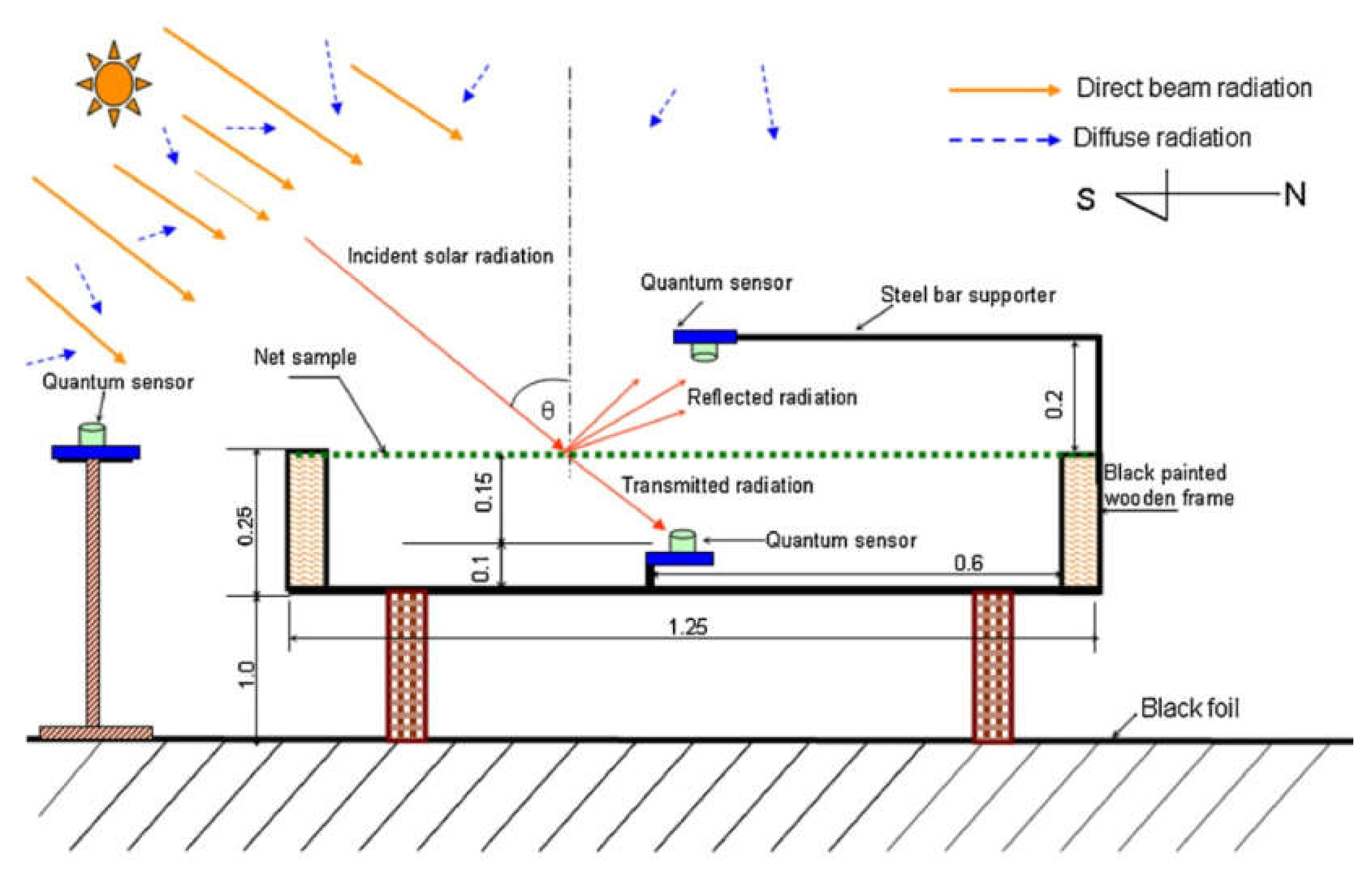


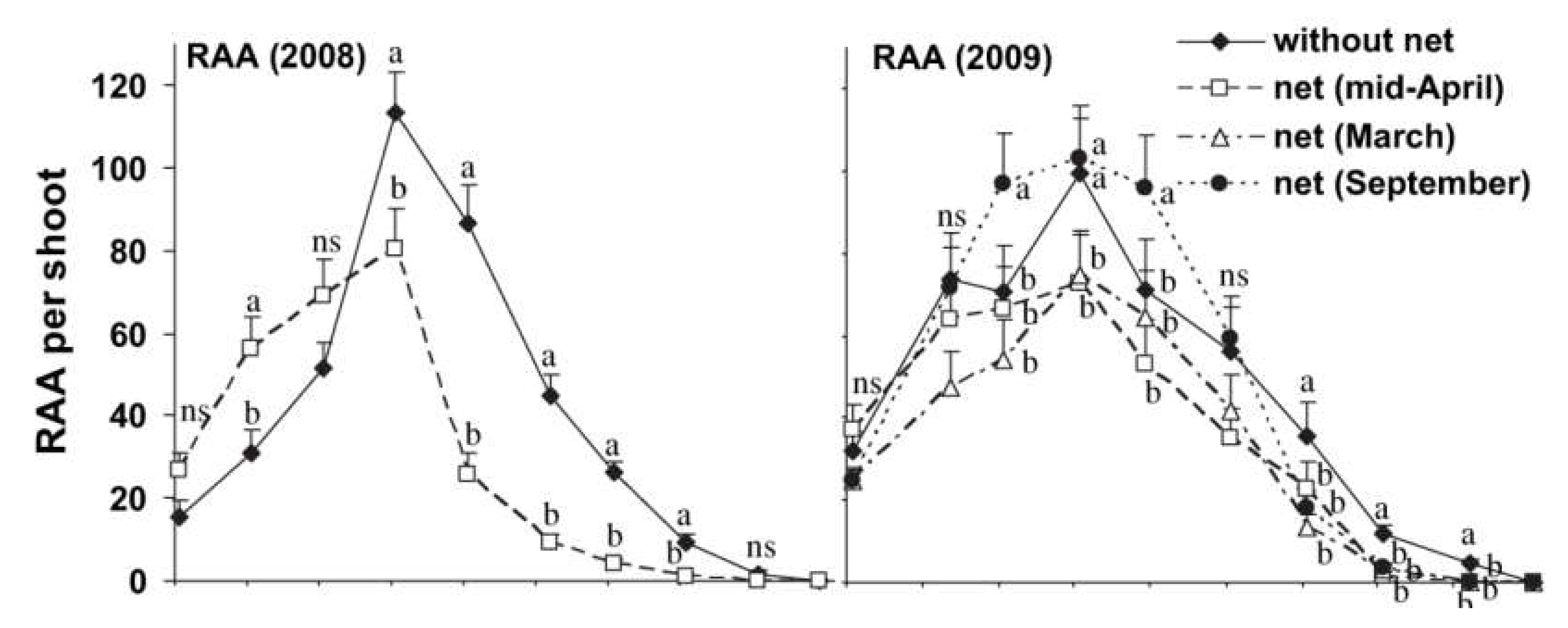
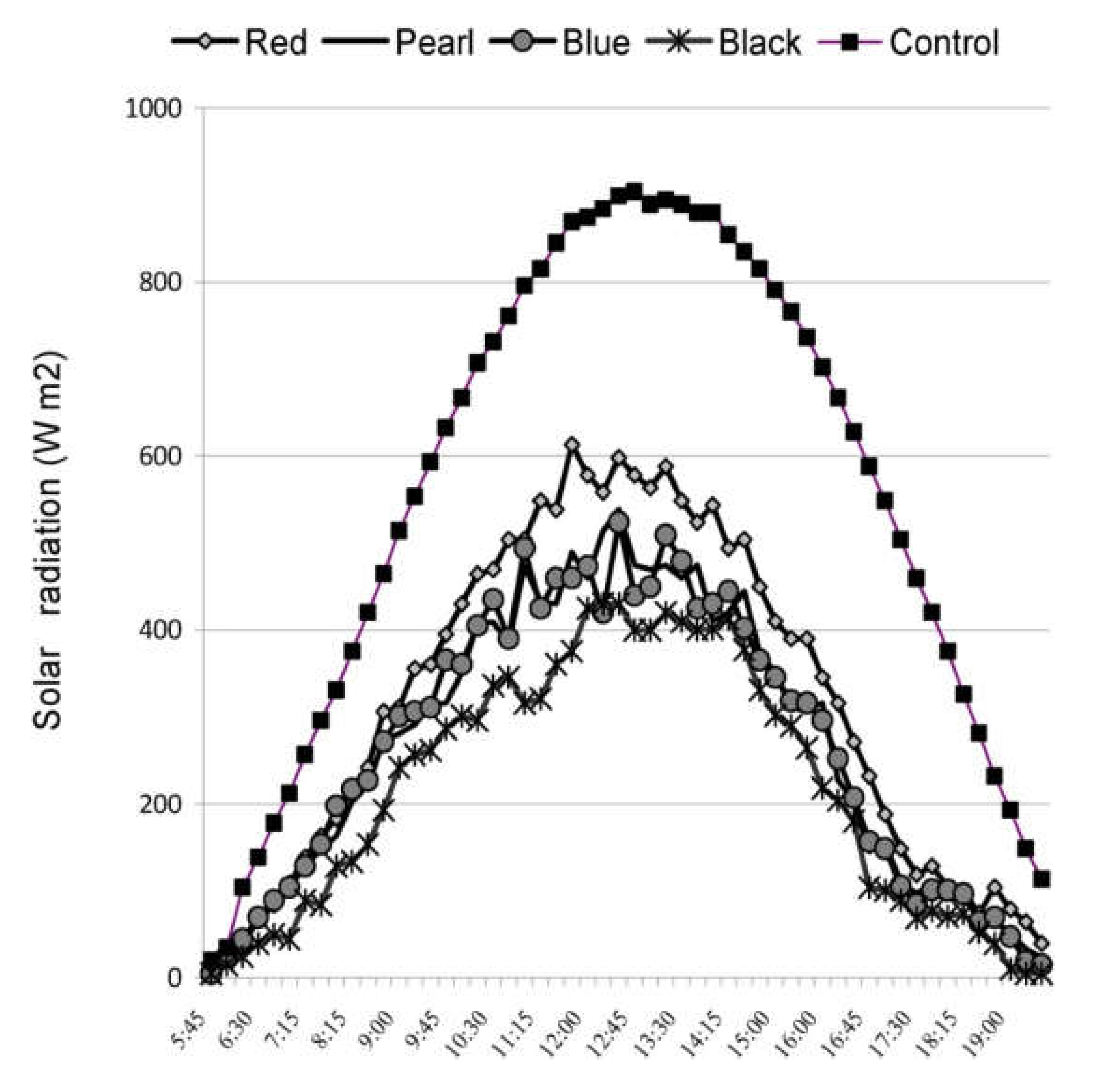



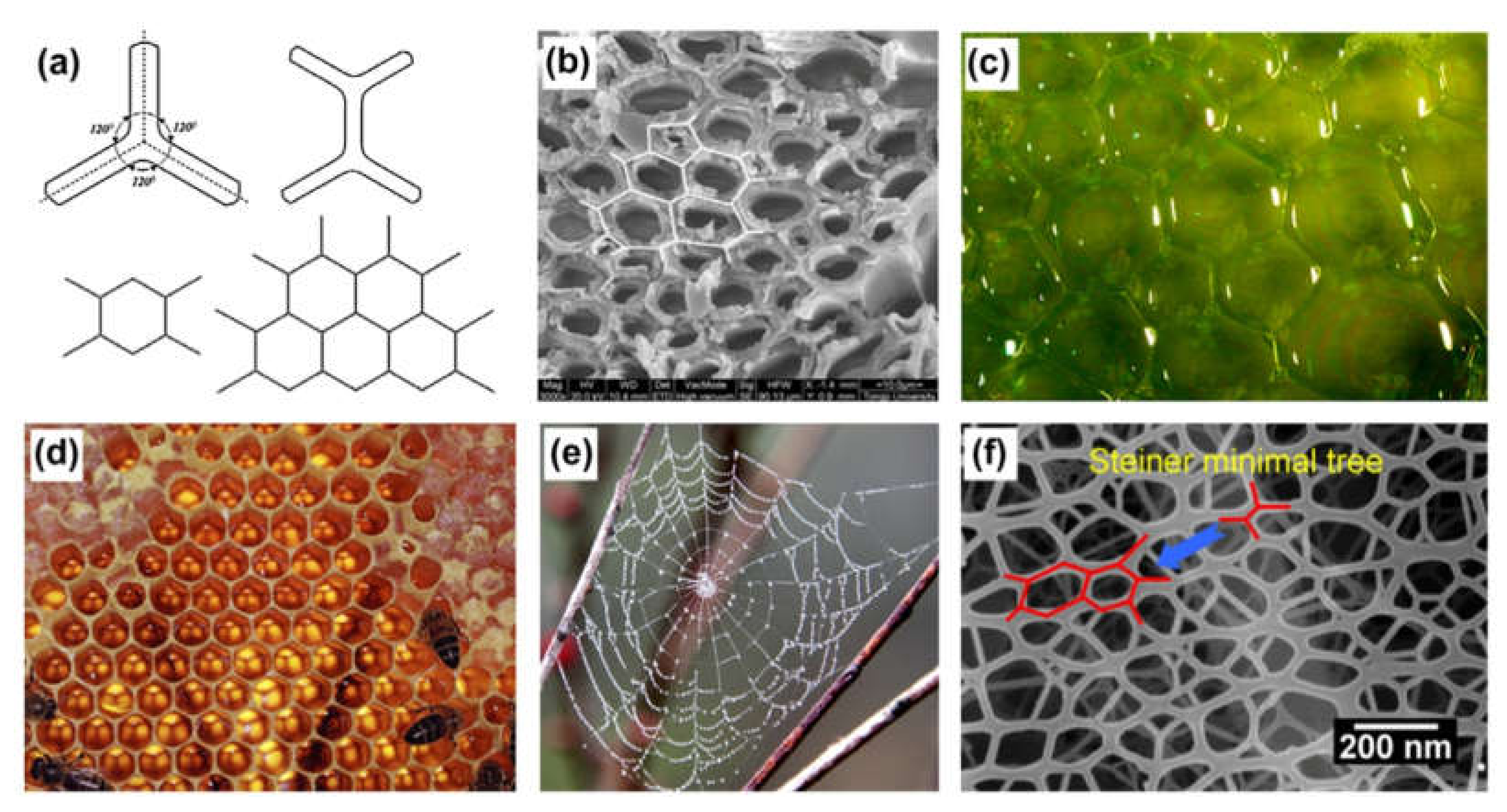

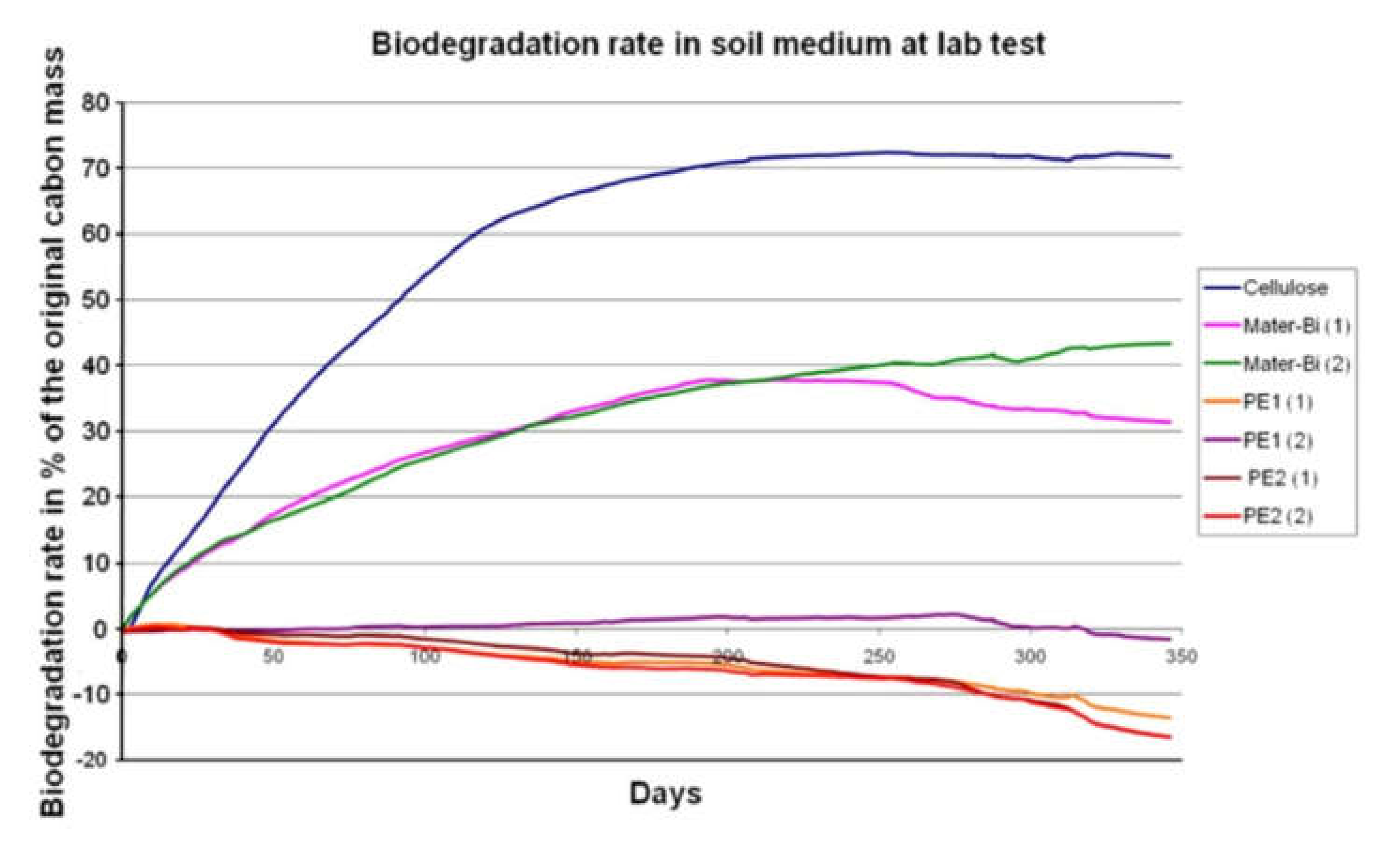
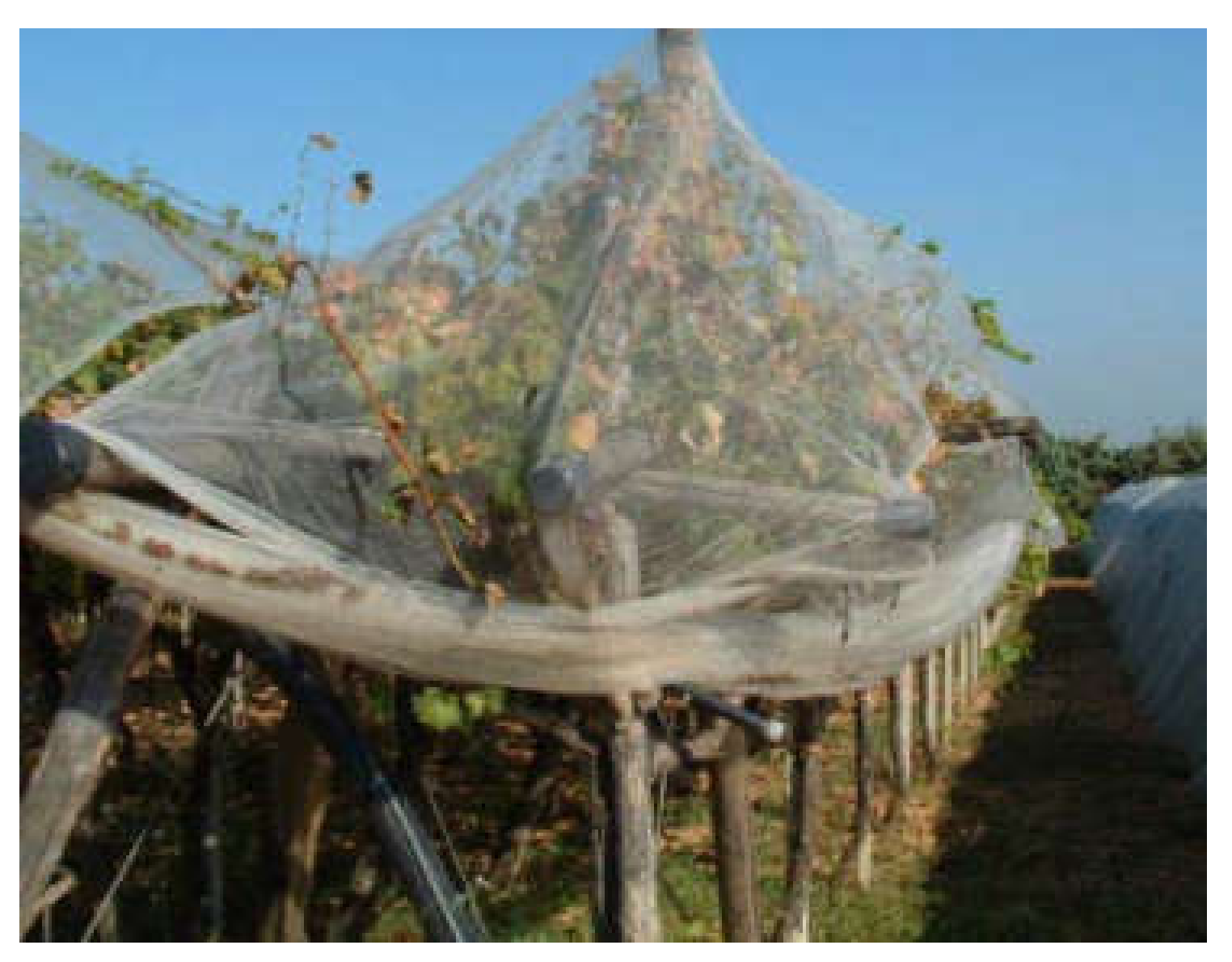

| Shading Nets | Mass of Dart (g) | Equivalent Hailstone Diameter (mm) | Equivalent Hailstone Energy (J) | Comments |
|---|---|---|---|---|
| OMBR50 | 444 | 52 | 39 | |
| OMBR70 | X1568 | X75 | X166 | The samples do not break |
| OMBR90 | X1568 | X75 | X166 | The samples do not break |
| HEX | 1324 | 71 | 136 | |
| LIBC30 | 717 | 60 | 68 | |
| LIBC50 | X1568 | X75 | X166 | The samples do not break |
| LIBC60 | X1568 | X75 | X166 | The samples do not break |
| LIBC70 | X1568 | X75 | X166 | The samples do not break |
| AGR30 | 418 | 51 | 37 | |
| AGR50 | 510 | 48 | 29 | Method A |
| AGREW | 452 | 47 | 25 | Method A |
| SHNB | 852 | 63 | 82 | |
| SHNT | ||||
| Antihail nets | ||||
| FRU26 | 584 | 56 | 54 | |
| FRU44 | 826 | 62 | 80 | |
| IRID | 800 | 62 | 77 | |
| ANTH | 634 | 58 | 59 | |
| GRKR | 700 | 59 | 66 | |
| Anti-insect nets | ||||
| BIO40 | X1568 | X75 | X166 | Cracks along the circular grip |
| BIO50 | X1568 | X75 | X166 | Cracks along the circular grip |
| IMPOL | 593 | 57 | 54 | |
| INSK | X1568 | X75 | X166 | Cracks along the circular grip |
| INSM | X1568 | X75 | X166 | Cracks along the circular grip |
| INST | X1568 | X75 | X166 | The samples do not break |
| REMA | 356 | 49 | 30 | |
| Windbreak nets | ||||
| SC50 | X1568 | X75 | X166 | Cracks along the circular grip |
| SC75 | X1568 | X75 | X166 | Cracks along the circular grip |
| SCMD | X1568 | X75 | X166 | Cracks along the circular grip |
| WINT | X1568 | X75 | X166 | Cracks along the circular grip |
| BR 50 | X1568 | X75 | X166 | Cracks along the circular grip |
| Cultivar | Environment | Capsanthin (mg Lutein Eq./100 g DW) | Lutein (mg/100 g DW) | β-Cryptoxanthin (mg/100 g DW) | β-Carotene (mg/100 g DW) | Phytoene (mg/100 g DW) |
|---|---|---|---|---|---|---|
| Cultivator #1 | Shade net | 69.01 | 6.93 | 1.19 | 4.36 | 0.45 h |
| Cultivator #2 | Tunnel | 83.76 | 11.79 | 1.47 | 8.70 | 0.79 |
| Shade net | 69.81 | 9.57 | 1.33 | 6.22 | 0.59 | |
| Cultivator #3 | Tunnel | 72.57 | 13.53 | 1.36 | 10.19 | 0.753 |
| Shade net | 109.89 | 11.92 | 1.67 | 8.46 | 0.91 | |
| Cultivator #4 | Tunnel | 108.98 | 19.66 | 1.99 | 19.76 | 1.62 |
| Shade net | 80.25 | 7.20 | 1.34 | 4.85 | 0.64 | |
| Cultivator #5 | Tunnel | 76.31 | 17.63 | 1.60 | 11.93 | 0.90 |
| Shade net | 56.77 | 6.00 | 1.33 | 5.28 | 0.61 | |
| Tunnel | 61.264 | 12.22 | 1.50 | 12.44 | 1.139 |
| Polymer | Annual Production (Tons) | Examples of Trademark/ Company | Application |
|---|---|---|---|
| PLA | 217,000 | Ingeo/NatureWorks; | Packaging materials, medical implants, 3D printing polymers, textiles, electronics |
| Luminy/Total | |||
| Corbion; Lacty/ | |||
| Shimadzu Cor.; | |||
| Vyloecol/Toyobo | |||
| PHA | 30,000 | Minerv-PHA TM/Bio- | Packaging, compost bags, tissue Engineering |
| On; PHBH TM/Kaneka; | |||
| TephaFlex/Tepha; | |||
| Nodax TM/Danimer | |||
| Scientific; AirCarbon/ | |||
| Newlight Technologies |
| Treatments | At Harvest Weight Loss ± SD (%) | After Eight Days of Storage | ||
|---|---|---|---|---|
| Control | – | 4.0 | ±1.3 a | |
| Nets without CEO | – | 4.2 | ±1.2 a | |
| Nets with CEO | – | 4.2 | ±2.0 a | |
| Control | Firmness ± SD (N) | 20.3 | ±13.9 a B | |
| 58.1 | ±21.6 b A | |||
| Nets without CEO | 62.1 | ±7.3 b A | 26.2 | ±12.1 a B |
| Nets with CEO | 46.2 | ±15.4 a A | 27.9 | ±11.8 a B |
| Control | Total soluble solids ± SD (%) | 5.2 | ±0.8 b A | |
| 5.2 ± 0.5 a A | ||||
| Nets without CEO | 5.3 ± 0.7 a A | 5.0 | ±1.1 a A | |
| Nets with CEO | 5.5 ± 0.9 a A | 6.1 | ±1.3 b A | |
| Control | Titratable acidity ± SD (%) | 0.29 | ±0.06 a A | |
| 0.27 | ±0.04 a A | |||
| Nets without CEO | 0.30 | ±0.08 a A | 0.32 | ±0.09 a A |
| Nets with CEO | 0.30 | ±0.05 a A | 0.35 | ±0.08 a A |
| Control | Color (Hue) ± SD | 91.8 | ±5.3 a B | |
| 96.9 | ±4.1 a A | |||
| Nets without CEO | 96.4 | ±4.2 a A | 94.8 | ±1.8 a A |
| Nets with CEO | 98.7 | ±3.6 a A | 95.6 | ±3.4 a B |
| Control | Total carotenoids ± SD (μg g−1) | 40.0 | ±5.5 b B | |
| 6.7 ± 1.5 b A | ||||
| Nets without CEO | 4.1 ± 1.9 a A | 31.2 | ±8.9 a B | |
| Nets with CEO | 4.9 ± 1.8 a A | 36.5 | ±9.9 a b B | |
| Control | DPPH reduction ± SD (%) | 36.8 | ±6.6 a B | |
| 25.0 | ±6.4 a A | |||
| Nets without CEO | 58.1 | ±10.4 c A | 41.3 | ±8.2 b B |
| Nets with CEO | 41.1 | ±6.4 b A | 48.8 | ±9.9 c B |
| Control | CO2 production ± SD (mg × kg−1 × h−1) | |||
| 19.5 | ±10.5 a A | 40.3 | ±19.7 a B | |
| Nets without CEO | 47.1 | ±12.8 b A | 33.5 | ±17.6 a B |
| Nets with CEO | 45.4 | ±17.2 b A | 46.2 | ±19.2 a A |
| Control | Ethylene production ± SD (μg × kg−1 × h−1) | |||
| 1.0 ± 1.1 a A | 2.0 | ±1.4 a B | ||
| Nets without CEO | 1.8 ± 1.1 a A | 0.7 | ±0.5 a B | |
| Nets with CEO | 9.0 ± 9.7 b A | 6.3 | ±9.0 b A | |
| Treatment (Shade Nets) | Color | Shading Intensity | Blossom End Rot | “Cat Face” | Sun-Scald | Skin Cracking | Marketable Fruit Yield |
|---|---|---|---|---|---|---|---|
| Control | No shading | None | 2.2 a | 6.7 a | 11.6 a | 15.6 a | 63.9 b |
| Gr 34 | Green strips | 34% | 1.6 a | 4.3 a | 0.0 b | 8.2 b | 86.0 a |
| B and Gr 40 | Black and green strips | 40% | 1.4 a | 5.2 a | 1.0 b | 6.9 b | 85.6 a |
| B 40 | Black strips | 40% | 1.4 a | 1.7 a | 0.0 b | 8.0 b | 88.3 a |
| B 49 | Black strips | 49% | 0.8 a | 3.8 a | 1.2 b | 8.8 b | 85.3 a |
| Transmission Coefficient | Control | ||||
|---|---|---|---|---|---|
| (No Screen) | Gr 34 | B and Gr 40 | B 40 | B 49 | |
| PAR | – | 63.4 a | 57.4 b | 60.7 b | 51.3 c |
| NIR | – | 71.2 a | 60.7 c | 60.5 b | 53.4 c |
| TMB | – | 65.6 a | 58.8 b | 60.6 b | 52.2 c |
| B | 1.26 a | 1.16 b | 1.20 a | 1.26 a | 1.25 a |
| N | 1.30 a | 1.22 b | 1.26 a | 1.28 a | 1.27 a |
| B:R | 1.04 b | 1.13 a | 1.04 b | 1.02 b | 1.04 b |
| B:FR | 1.32 a | 1.30 a | 1.25 a | 1.28 a | 1.29 a |
| PAR:TMB | 0.58 a | 0.56 a | 0.57 a | 0.58 a | 0.58 a |
| PAR:NIR | 1.39 a | 1.23 c | 1.31 b | 1.39 a | 1.35 b |
© 2020 by the author. Licensee MDPI, Basel, Switzerland. This article is an open access article distributed under the terms and conditions of the Creative Commons Attribution (CC BY) license (http://creativecommons.org/licenses/by/4.0/).
Share and Cite
Maraveas, C. The Sustainability of Plastic Nets in Agriculture. Sustainability 2020, 12, 3625. https://doi.org/10.3390/su12093625
Maraveas C. The Sustainability of Plastic Nets in Agriculture. Sustainability. 2020; 12(9):3625. https://doi.org/10.3390/su12093625
Chicago/Turabian StyleMaraveas, Chrysanthos. 2020. "The Sustainability of Plastic Nets in Agriculture" Sustainability 12, no. 9: 3625. https://doi.org/10.3390/su12093625
APA StyleMaraveas, C. (2020). The Sustainability of Plastic Nets in Agriculture. Sustainability, 12(9), 3625. https://doi.org/10.3390/su12093625






